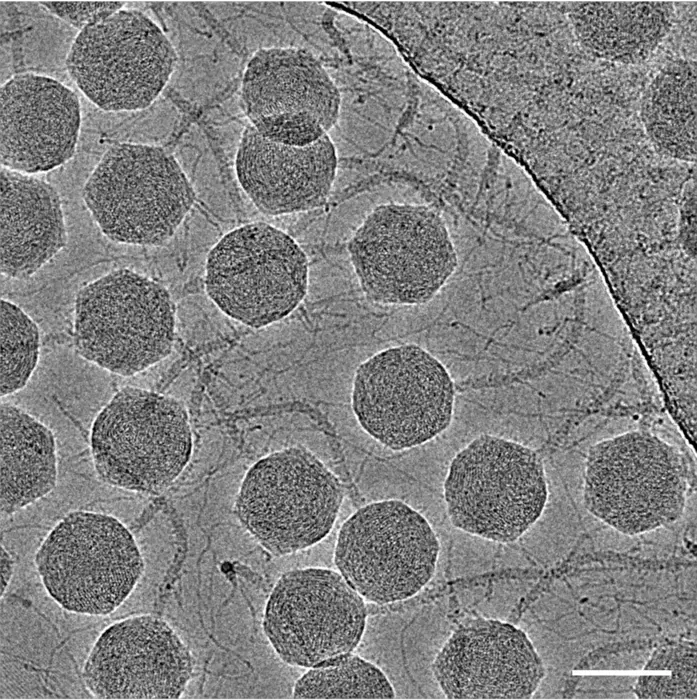Reviewed by Danielle Ellis, B.Sc.Dec 18 2023
The term “virus” is frequently linked with negative implications. Nevertheless, it is crucial to recognize that not all viruses are detrimental.
 An electron micrograph — a photograph taken by means of a transmission electron microscope — of the DT57C bacteriophage. These types of images have been used to obtain a three-dimensional structure of the entire virus. Scale bar: 80 nanometers. Image Credit: OIST
An electron micrograph — a photograph taken by means of a transmission electron microscope — of the DT57C bacteriophage. These types of images have been used to obtain a three-dimensional structure of the entire virus. Scale bar: 80 nanometers. Image Credit: OIST
Indeed, numerous viruses coexist within human bodies, playing crucial roles in maintaining human health. One illustrative example is bacteriophages, which are viruses that target bacteria and can be employed to manage bacterial infections.
These viruses exhibit intricate structures, and until now, their atomic-level details have not been thoroughly explored. They can be manipulated to better align with human interests, such as offering an alternative to antibiotic usage.
Researchers from the Okinawa Institute of Science and Technology (OIST), in collaboration with international partners at MSU Moscow, Shenzhen, and Academia Sinica in Taiwan, have delved into the molecular architecture of tequintavirus, also known as T5-like bacteriophages. The aim is to comprehend how these viruses are organized at the molecular level.
T5 viruses are nonenveloped, featuring an icosahedral-shaped head containing viral DNA and a non-contractile flexible tail serving as the conduit for injecting DNA into the bacterial host cell.
The scientists successfully generated atomic models for all structural components of the virus, marking the first instance of a tailed virus with a flexible tail being fully elucidated at this detailed level.
The outcomes of their research have been documented in the journal Nature Communications, laying the groundwork for future investigations into the infection mechanisms of these viruses.
To engineer and modify these viruses efficiently for specific purposes, we must know their organization at an atomic level and the mechanisms through which they infect their target bacteria. For these reasons, we decided to use cryo-electron microscopy to visualize the DT57C bacteriophage at high-resolution in its entirety.”
Matthias Wolf, Professor and Head, Molecular Cryo-Electron Microscopy Unit, Okinawa Institute of Science and Technology
Scientists engaged in phage therapies, utilizing bacteriophages to address bacterial infections in agricultural crops, fish aquaculture, and various domains, can draw valuable insights from the findings of this study.
The structural knowledge we have obtained can enable the engineering of bacteriophages with improved ability to kill these bacterial pathogens.”
Matthias Wolf, Professor and Head, Molecular Cryo-Electron Microscopy Unit, Okinawa Institute of Science and Technology
Does this imply that bacteriophages are considered “good” viruses? Dr Rafael Ayala, the primary author of the research paper, clarified that these viruses are deemed “good” when their actions are beneficial to us and “bad” when they result in harm, as is the case with bacteria. An illustration of how bacteriophages can be advantageous is their application in gene therapy.
One of the ways to distribute genes to cells is to put them into a human virus that has been modified in two ways, first to not cause disease, and second to also carry the genes that you want to introduce to cure a specific disease. In this way, the virus is used as a vehicle to introduce a cure.”
Dr Rafael Ayala, Study Lead Author, Okinawa Institute of Science and Technology
A primary obstacle in the research involved intricately reconstructing the entire DT57C bacteriophage from electron micrographs, encompassing not only some but all of its components.
The DT57C bacteriophage consists of a head, a neck, a tail, and a baseplate at the tail's end. Many of these components are flexible and exhibit free movement, posing a challenge in visualizing their molecular architecture in precise detail, akin to capturing a high-quality photo of a swiftly moving object.
In response to this challenge, the researchers devised novel methods that they intend to implement in studying other viruses with intricate shapes.
Dr Ayala added, “We had to think of new ways to tackle the problems we encountered, and we believe that the methods developed in this study will be of interest to many researchers studying viruses. Phage therapy is an active area of research, and it is very likely that we are going to see these treatments in our lifetime.”
Leveraging viruses to alter bacteria is a significant field of study, given that bacteria play a central role in numerous natural and engineered processes.
These processes encompass nutrient recycling, symbiosis, bioremediation (utilizing bacteria to cleanse environmental pollutants), and food production. The outcomes of this research hold promise in the development of viruses tailored to combat bacterial diseases affecting humans, plants, and other organisms.
Source:
Journal reference:
Ayala, R., et al. (2023) Nearly complete structure of bacteriophage DT57C reveals architecture of head-to-tail interface and lateral tail fibers. Nature Communications. doi.org/10.1038/s41467-023-43824-9